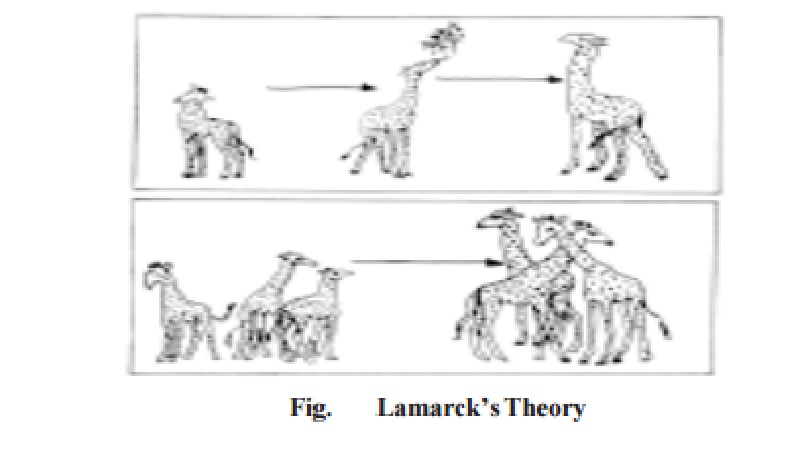Chapter: 11th 12th standard bio zoology Human Body higher secondary school
THEORIES OF EVOLUTION : Lamarckism

THEORIES OF EVOLUTION
Introduction
Several opinions had been made available to explain the origin and existence of various forms of life. The existing living beings show characteristic resemblances in form and functions. There are evidences for succession of several types of living organisms occupying earth. Populations of animals and Plants tend to undergo predictable changes in their population intensities. An explanation to all these interesting natural happenings had been attempted through various modern theories of evolution. An initiation for such evolutionary thought process was well provided by Lamarck. This evolutionary theorizing culminates in the modern synthetic theory of evolution afforded by different fields in biology.
Lamarckism
Jean Baptiste de Lamarck (1744 - 1829) is well known for his theory of evolution. In 1809 he published his book titled 'Philosophie Zoologique'. This book contains his views on evolutionary mechanisms. Eventhough the views of Lamarck are not fully accepted, he occupies a very important place in the history of evolutionary thought.
The theory of evolution as proposed by Lamarck is popularly known as the 'theory of inheritance of acquired characters'. According to this theory modifications or changes acquired during the life time of an organism can automatically be transmitted to succeeding generations. While elaborating this theory, Lamarck advanced four laws or propositions.
I Law (or) Proposition
'In evolution, during course of time, organisms or their component parts gradually tend to increase in size.
Lamarck cited the evolution of horses as an example to explain this law. The modern horses, namely, Equus evolved from very small ancestral forms called Hyracotherium or Eohippus. Such small forms survived years ago. They gradually evolved into larger modern Equus.
Lamarck's opinion was based on fossils of several intermediate ancestors of horses. Whose fossils had already been discovered. However during recent years various other fossils had been obtained. Of these fossils, some of them are much smaller than their immediate ancestors. This finding is against the view already expresed by Lamarck. Thus the first law of Lamarck lost its significance.
II Law or Proposition
'If an organism is 'in need' of an organ, sooner or later it will arise.
This view of Lamarck emphasized the significance of mind and its thinking being related to needs in an environment. Thus, according to Lamarck a continuous thinking for several generations can lead to the origin of an adaptive character. Lamarck elaborated his view citing the lengthening of neck in giraffee over the years.
It is known through fossil records that the ancestors of modern giraffe were small and they had short neck and forelimbs. They lived in the grasslands of Africa. These ancestral animals were feeding on grasses and the leaves of small trees nearby. Gradually, as the grasslands were transformed into deserts, the animals became dependent on trees for food. Due to competition for food they had to stretch their neck for more leaves. They strained their neck for several generations with a very strong inner feeling to have longer neck. This strong desire, in course of time, led to gradual increase in the length of neck and forelimbs.
In this explanation Lamarck considered that mere 'want' or 'inner f e e l i n g ' to possess a particular character can lead to theorigin of such a character. This view of Lamarck is not accepted by modern evolutionists.
III Law (or) Proposition - Law of use and disuse
According to this law, constant use of an organ changes its efficiency and makes that organ to increase in size with better development. Similarly if an organ is not used for a long time, it might lead to reduction in efficiency and size of that organ. The development of hand muscles of a blacksmith and thigh muscles in the legs of an experienced runner were quoted as examples. Eventhough this view of Lamarck is correct and acceptable, it is not relevant to evolution due to lack of inheritance.
IV Law (or) Proposition. Inheritance of Acquired Characters
'Bodily changes or new charateristics obtained by an organism during its life time will automatically get transferred to the next generation'.
While proposing this law, Lamarck did not provide any specific example. He simply believed that due to conditions prevalent in an environment, an organism can use an organ extensively and such an usage can lead to more efficient and perfect nature of that organ. Similarly, an organ not used for a longer period would degenerate. These perfect or degenerate characteristics will be inherited by subsequent generations resulting in new types.
The IV Law of Lamarck had been subjected to severe criticisms. Several experiments had been carried out, either to prove or disprove this concept.
In 1890, the German Scientist, August Weismann performed some experiments with the rats. He selected a set of healthy male and female rats. He started cutting their tails continually for more than twenty generations. This experiment was performed to verify inheritance of the acquired character, namely the tailless condition. Interestingly such a condition was never observed in any of the young rats born. This finding led to the proposition of the theory, that any change to the body regions (somatoplasm) will not have influence over the reproductive cells (Germplasm). Thus Weismann, for the first time segregated germplasm from the somatoplasm.
This lead to the formulation of the 'Germplasm theory' which states that 'any change to the somatoplam will not have an influence over the germplasm'.
Related Topics